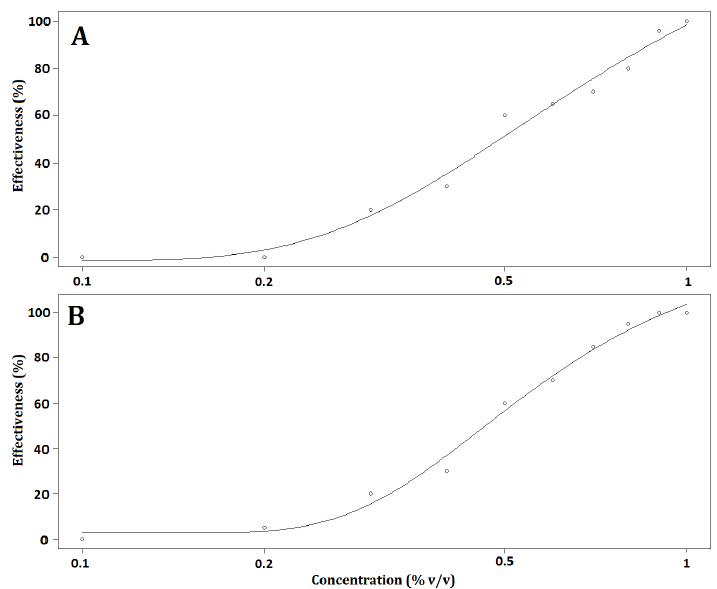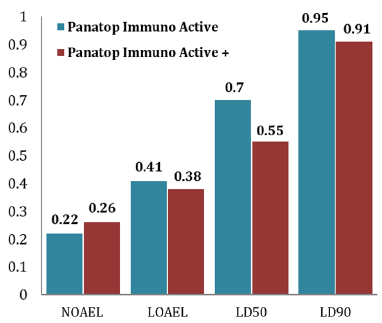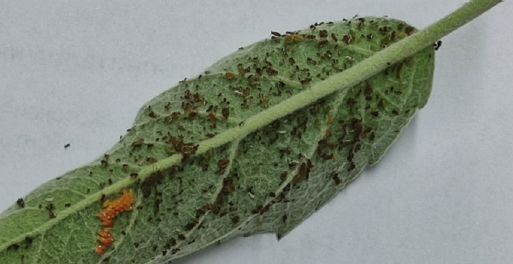Donyo Ganchev 1*
1, Agricultural University, Plovdiv, Bulgaria
E-mail:
donyo@abv.bg
Received: 25/07/2021
Acceptance: 25/10/2021
Available Online: 26/10/2021
Published: 01/01/2022

Manuscript link
http://dx.doi.org/10.30493/DAS.2021.296672
Abstract
The insecticidal activity of novel mineral-based fertilizers by Panamin Asutria towards Aphis pomi was tested. For this purpose, in vitro and in vivo trials were carried out. In vitro tests showed that Panatop Immuno Active and Panatop Immuno Active+ have strong contact insecticidal action at their fertilizer rates of 1 % (v/v), comparable with most commercial synthetic insecticides. As for in vivo trials, no phytotoxic effects were observed during the experiment of the products in all tested varieties of apple trees, even when used at rates tenfold higher than recommended on their labels as fertilizers. Using these types of products can be economical and safe for humans and the environment with low resistance risk towards insects.
Keywords: Mineral-based fertilizers, Aphids, Apples, Rock meal
Introduction
The fact that some mineral-based or organic fertilizers can manifest insecticidal activity is not new or unique. For example, in 1984 synergist insecticidal activity of urea and ammonium nitrate against Tribolium confusm was established [1]. Researches claim that rock meal mechanically blocks the airflow in insects’ spiracles, making it impossible to breathe [2]. High fertilizer application rates were proven to influence bollworm (Helicoverpa zea) and certain insect predators [3]. Phosphorus– potassium– and nitrogen-containing liquid suspension also showed a strong insecticidal activity [4].
Rock meals are essential mineral-based fertilizers and soil amendments in sustainable and organic agricultural production systems [5-8]. Its main effects are represented by improving the texture of clay soils by adding rock dust powder in various amounts [9] and as a soil re-mineralizer [10] with other side pesticidal benefits. The application of granite rock dust resulted in lower herbivore damage on Lily plants [11]. The effectiveness of clinoptilolite (a naturally occurring zeolite) treatment was investigated in search of organic and integrated pest management (IPM) compatable control method against pollen beetle Meligethes spp in oilseed fields. The results showed that clinoptilolite treatment resulted in a significant reduction (50-80%) in the number of pollen beetles under dry and sunny conditions [12]. The insecticidal effect of different formulations of granite dust against Plutella xylostella and Trichoplusia ni exceeded other mineral-based and dust-based pest management products [13]. Basalt rock dust was also reported as an insecticide in organic peach production systems [14][15]. Furthermore, rock dust showed considerable effectiveness against tomato spotted spider mites when used in soil or as a foliar application [16][17]. Rock dust nanoparticles were established to improve seed germination and seedling vigor of native species [18].
The presented introduction clearly shows that rock meals or dust have a long proven record of insecticidal action towards different pest species. Therefore, the present research aimed to examine the eventual in vitro and in vivo effectiveness of the mineral-based fertilizers on the base of rock meal towards one of the most spread and harmful aphid species on apples – Aphis pomi.
Materials and methods
Tested products
Four mineral fertilizers produced by Panamin Asutria [19] were used in the present study on the base of rock meal mixtures and different mineral substances, with major components (calcium, magnesium, and silicon) and additional elements such as iron, phosphates, and potassium. The same products are also used as dietary supplements in animal feeding [20]:
- Panamin Agro: Based on a mixture of rock powder from the highest quality Austrian volcanic rocks, minerals, and limestone. This product is used as a plant stimulator for all types of cultures.
- Panatop Immuno Active: A suspension plant simulator with high content of calcium and magnesium oxide
- Panatop Immuno Active+: A three-component suspension plant stimulant with a high calcium, magnesium, and copper content.
- Panatop Immuno Save: A pure and highly concentrated suspension fertilizer containing potassium, silicon, and copper
Insecticidal tests methodology
Aphis pomi individuals were obtained from infested apple orchard trees and used in the current study. In vitro trials were conducted firstly to investigate the eventual insecticidal activity of the tested products. The trials were conducted according to [21]. Five layers of standard filter paper were put on the bottom plastic cups with a volume of 400 ml. 5 ml of testing product in 10 different concentrations was poured to wet the paper layers in each cup. After that, 10 adult aphids were placed on the wetted paper. In control, the test products were substituted with 5 ml of distilled water was used. The cups were covered with greenhouse antiinsect mesh tightening to the cups with rubber bands. Each treatment at each concentration was replicated five times (5 cups). The mortality rates were reported and calculated after 24 and 48 h with Abbot formula [22]. After conducting in vitro trials, in vivo tests with tested products were performed. The LD90 concentration of in vitro tests for each effective product was sprayed on apple orchard trees from different varieties infected with Aphis pomi. During these trials, plants were also observed for phytotoxic manifestations [23-25].
Mathematical analysis of data
The Dose-Response modeling for establishing NOAEL (No Observed Adverse Effect Level =LD05), LOAEL (Lowest Observed Adverse Effect Level = LD25), LD50, and LD90 [26]was performed with R language for Statistical Computing and DRC package [27-29].
Results and Discussion
In vitro and in vivo trials results reveal that two of the tested products (Panatop Immuno Active and Panatop Immuno Active+) expressed strong insecticidal activity towards aphid species. The Dose-Response Models (Curves) shows that LD50 was established under concentrations of 0.7 and 0.55% (v/v), while LD90 was established under concentrations of 0.95 and 0.91% (v/v) of Immuno Active and Immuno Active+, respectively (Fig. 1 A and B) and (Fig. 2). Two of the tested products: Panamin Agro and Panatop Immuno Save did not express any insecticidal activity even at tenfold higher rates than recommended on their labels as fertilizers.


In vivo trials revealed an absolute insecticidal activity of both Panamin Immuno Active and Panatop Immuno Active+ on Aphis pomi. Treatments with 1 % (v/v) concentration resulted in total elimination of aphids on apples as a contact insecticide without any phytotoxic damages on plants (Fig. 3).

The recommended concentration of Panatop Immuno Active and Panatop Immuno Active + as plant stimulants and fertilizers is also 1 % (v/v). The presented results show that the tested products (Panatop Immuno Active and Panatop Immuno Active + ) express their full insecticidal potential against aphids at this concentration. The used products have similar insecticidal effectiveness to most commercially available insecticides (Fig. 3). No phytotoxic manifestations were observed during the experiment in all tested varieties of apple trees, even when they were tested at tenfold higher rates than recommended convention on their labels as fertilizers (1 % v/v). This finding highlights the safeness of this control method on the plant in agricultural production systems as similarly reported previously using other similar materials [5-8][11-18]. The main insecticidal effect of the reported products is mechanical [2]. Therefore, the main disadvantage of its mode of action is the lack of systemic insecticidal activity. However, this disadvantage might be compensated for by these products’ capability of inducing biotic and abiotic stress resistance in the plant [30][31].
Conclusions
The present study reveals that Panatop Immuno Active and Panatop Immuno Active+ can act as a contact insecticide towards aphids in the same doses in which they are applied as fertilizers and plant stimulators [ 1 % (v/v)]. This application can provide simultaneous protection of the plants combined with a growth boost. The other advantages of this treatment are the low risk of resistance development, the complete lack of phytotoxicity in treated plants, the induced plant biotic and abiotic resistance, and its safeness for humans and the environment.
Acknowledgments
This research was conducted under project KP-06-IP-China/2: “Research on sustainable pest and disease management in apple orchards in Bulgaria and China based on precision ecological control methods” between Agricultural University Plovdiv, Bulgaria and Zhengzhou Fruit Research Institute, China.
The author and respectively Agricultural University – Plovdiv, received a grant from Panamin Co Ltd (The Representative for Bulgaria, North Macedonia, Greece, Turkey, and Romania of Panamin GmbH Austria) for evaluation of ISR elicitor activity of the company’s products, including those presented in the current paper
References
| 1 | Veverka K, Oliberius J. Synergistic insecticidal activity of urea and ammonium nitrate. J Plant Dis Prot. 1985;92(3):258-62. |
| 2 | Blachowski J, Kaźmierczak U, Górniak-Zimroz J. Spatial and Quantitative Analysis of Waste from Rock Raw Minerals Mining: A Case Study of Lower Silesia Region in Poland. Sustainability. 2018;10(12):4493. DOI |
| 3 | Adkisson PL. The influence of fertilizer applications on populations of Heliothis zea (Boddie), and certain insect predators. J. Econ. Metall. 1958;51(6):757-9. DOI |
| 4 | Sobirov MM, Tadjiev SM, Sultonov BE. Preparation of phosphorus-potassium-nitrogen containing liquid suspension fertilizers with insecticidal activity. J. Chem. Technol. Metall. 2015;50(5):631-7. |
| 5 | Schüler G. Initial compensation of acidic deposition in forest ecosystems by different rock meals. Water Air Soil Pollut. 1990;54(3):435-44. DOI |
| 6 | Leonardos OH, Fyfe WS, Kronberg BI. The use of ground rocks in laterite systems: an improvement to the use of conventional soluble fertilizers?. Chem. Geol. 1987;60(1-4):361-70. DOI |
| 7 | Winiwarter V, Blum WE. From marl to rock powder: On the history of soil fertility management by rock materials. J. Plant. Nutr. Soil Sci. 2008;171(3):316-24. DOI |
| 8 | Tito GA, Chaves LH, de Souza FG, Dantas ER, Guerra HO, Cavalcante AR, da Silva Mendes J. Effect of bentonite and vermicompost associated with MB4 in soil amendment and maize growth. SYLWAN. 2020;164(8):138-56. |
| 9 | Eltwati AS, Tarhuni F, Elkaseh A. Engineering properties of clayey soil stabilized with waste granite dust. Int. J. Adv. Sci. Technol. 2020;29(10S):750-7. |
| 10 | Ramos CG, de Medeiros DD, Gomez L, Oliveira LF, Schneider IA, Kautzmann RM. Evaluation of soil re-mineralizer from by-product of volcanic rock mining: experimental proof using black oats and maize crops. Nat. Resour. Res. 2020;29(3):1583-600. DOI |
| 11 | Faraone N, Hillier NK. Preliminary Evaluation of a Granite Rock Dust Product for Pest Herbivore Management in Field Conditions. Insects. 2020;11(12):877. DOI |
| 12 | Daniel C, Dierauer H, Clerc M. The potential of silicate rock dust to control pollen beetles (Meligethes spp.). IOBC wprs Bulletin. 2013;96:47-55. |
| 13 | Faraone N, MacPherson S, Hillier NK. Evaluation of repellent and insecticidal properties of a novel granite dust product in crop protection. J Pest Sci. 2018;91(4):1345-52. DOI |
| 14 | Ames GK. Peaches: Organic and low-spray production. NCAT. ATTRA. 2012. |
| 15 | Conti B. Natural Substances against Insect Pests: Assets and Liabilities. Insects. 2021;12(3). DOI |
| 16 | Faraone N, Evans R, LeBlanc J, Hillier NK. Soil and foliar application of rock dust as natural control agent for two-spotted spider mites on tomato plants. Sci. Rep. 2020;10(1):1-9. DOI |
| 17 | Glemser E, McFadden-Smith W, Parent JP. Evaluation of compounds for repellency of the multicoloured Asian lady beetle (Coleoptera: Coccinellidae) in vineyards. Can. Entomol. 2021;153(4):470-81. DOI |
| 18 | Arnott A, Galagedara L, Thomas R, Cheema M, Sobze JM. The potential of rock dust nanoparticles to improve seed germination and seedling vigor of native species: A review. Sci. Total Environ. 2021;775:145139. DOI |
| 19 | Panamin Co [Internet]; 2017. Link |
| 20 | Yordanova D, Angelova T, Krastanov J, Miteva D, Karabashev V, Kalaydzhiev G. Influence of Panamin Animal and Panamin Detox on milk coagulation properties of dairy cows. J. Agric. Sci. Technol. 2020;12(4):353-6. DOI |
| 21 | Kenaga EE, Whitney WK, Hardy JL, Doty AE. Laboratory tests with Dursban insecticide. J. Econ. Entomol. 1965;58(6):1043-50. DOI |
| 22 | Abbott WS. A method of computing the effectiveness of an insecticide. J. Econ. Entomol. 1925;18(2):265-7. DOI |
| 23 | Ogeleka D, Bokolo P, Omoregie G. Assessment of the Phytotoxic Effects and Ecological Risks to Phaseolus vulgaris Planted on Crude Oil Spiked Soils. Tanzan. j. sci. 2020;46(1):116-28. |
| 24 | Brdar-Jokanović M. Boron toxicity and deficiency in agricultural plants. Int. J. Mol. Sci. 2020;21(4):1424. DOI |
| 25 | Dudic M, Meseldzija M, Ljevnaic-Masic B, Rajkovic M, Markovic T, Begovic R, Jurisic A, Ivanovic I. Weed composition and control in apple orchards under intensive and extensive floor management. Chil. J. Agric. Res. 2020;80(4):546-60. DOI |
| 26 | Calabrese EJ, Baldwin LA. Hormesis: the dose-response revolution. Annu. Rev. Pharmacol. Toxicol. 2003;43(1):175-97. DOI |
| 27 | Computing R. R: A language and environment for statistical computing. Vienna: R Core Team. 2013. |
| 28 | Ritz C, Baty F, Streibig JC, Gerhard D. Dose-response analysis using R. PloS one. 2015;10(12):e0146021. DOI |
| 29 | Streibig JC, Ritz C. Dose response curve analysis with the freeware programme–R. Outlooks Pest Manag. 2006 Apr 1;17(2):88-9. DOI |
| 30 | Valchev D, Valcheva D. Study on the influence of Panamin leaf fertilizer on plant development, resistance to abiotic stress, productivity and grain quality of wheat and barley. J Agric Plant Sci. 2019;17(1):151-7. |
| 31 | Velesanova I, Trajkova F, Koleva Gudeva L. Spectrophotometric determination of the content of photosynthetic pigments in some decorative species grown in in vitro and in vivo conditions. In: 2nd International Meeting Agriscience & Practice. 2019. |
Cite this article:
Ganchev, D. Insecticidal action of mineral-based fertilizers towards Aphis pomi on apple trees. DYSONA – Applied Science, 2021;3(1): 8-14. doi: 10.30493/das.2021.296672
